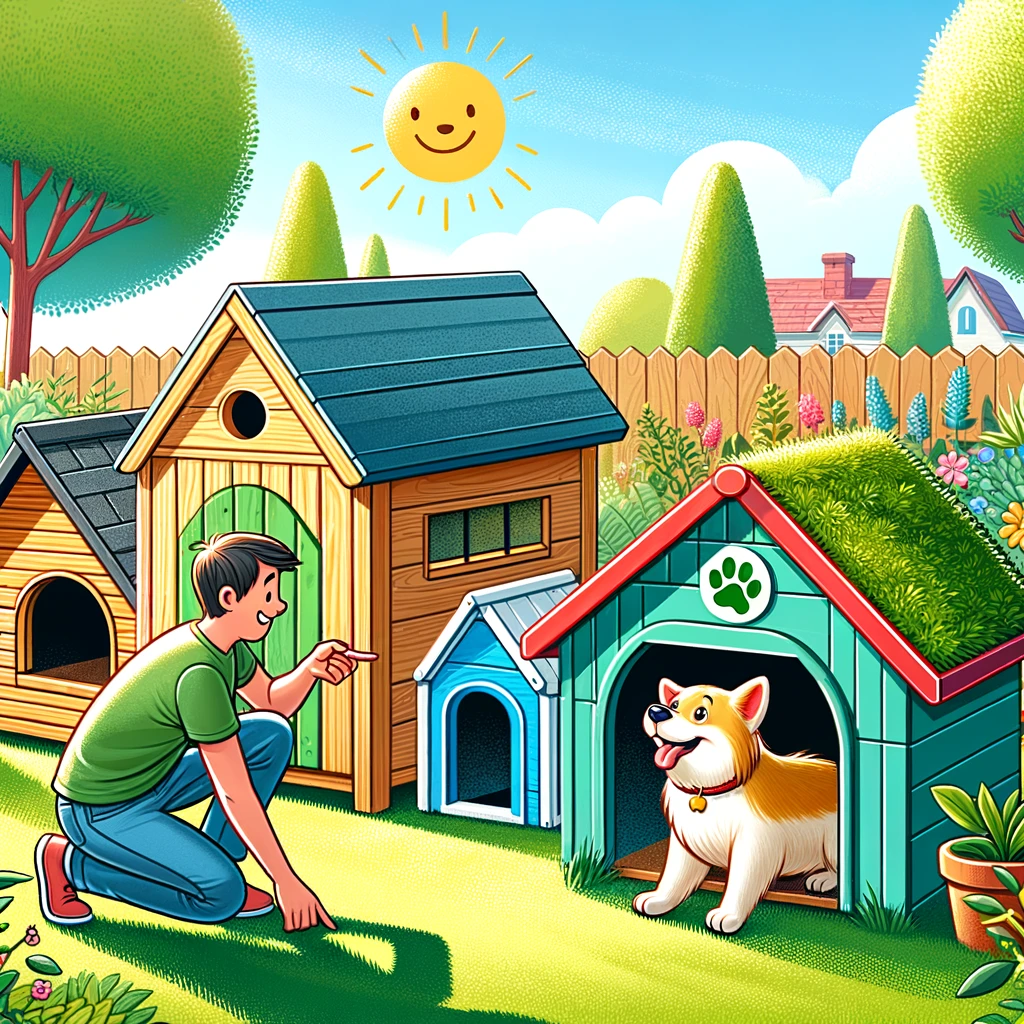Dog ramps are a practical accessory for pet owners who want to improve their dog’s mobility and quality of life.
Whether your dog is small, aging, or managing joint problems, a ramp can provide a safe passage to higher surfaces like beds, couches, or cars. Using a dog ramp helps to minimize the stress on their joints, reducing the risk of injury from jumping on or off elevated areas.
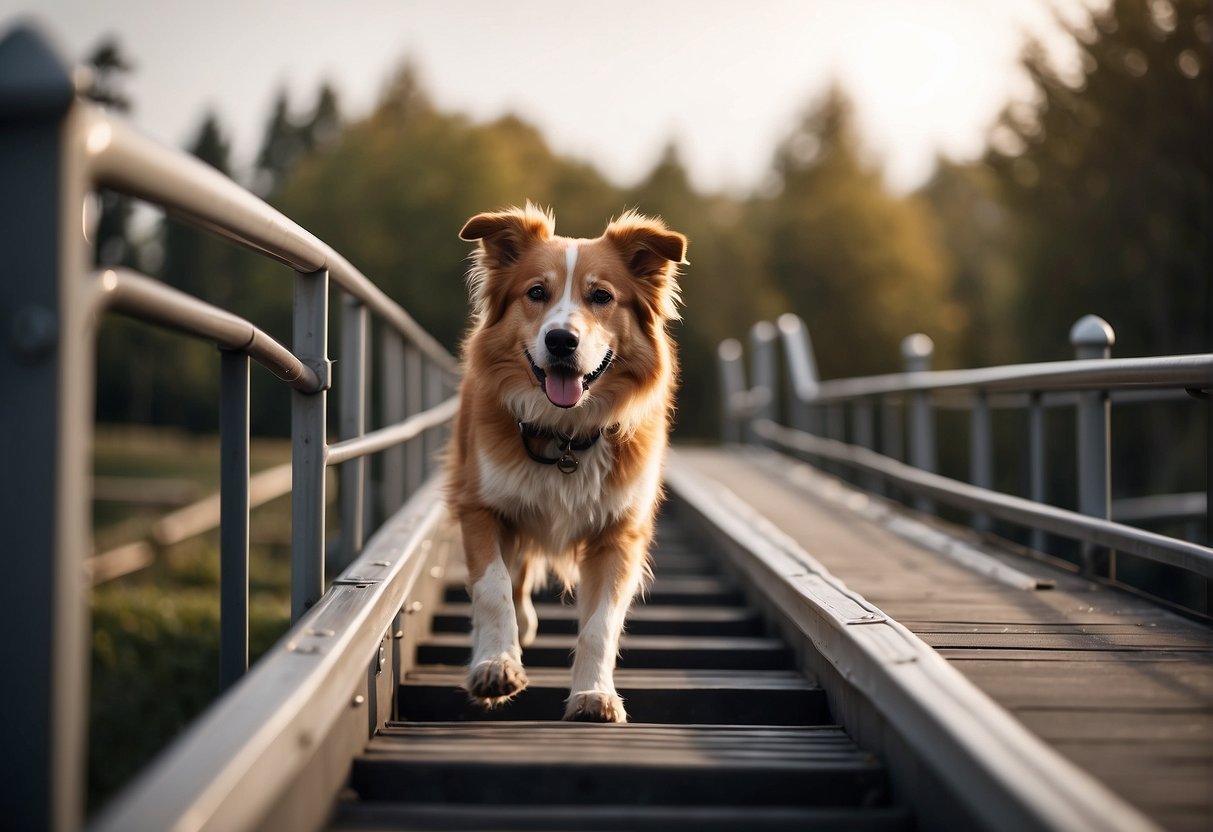
Key Takeaways
- Dog ramps improve accessibility and safety for pets with mobility issues, helping them reach furniture or vehicles while reducing injury risk.
- Various ramp designs cater to different needs, including adjustable, folding, and permanent options for both home and vehicle use.
- Choosing the right ramp requires considering its size, weight capacity, material, and safety features to ensure it supports your dog securely and lasts long.
- Ramps are particularly beneficial for aging dogs or those with arthritis, offering a gentle way to move around and supporting joint health.
- Effective ramp use involves proper setup, regular maintenance, and selecting suitable accessories, guaranteeing safety and convenience for your dog and a good fit with home decor.
Dog Ramps Basics
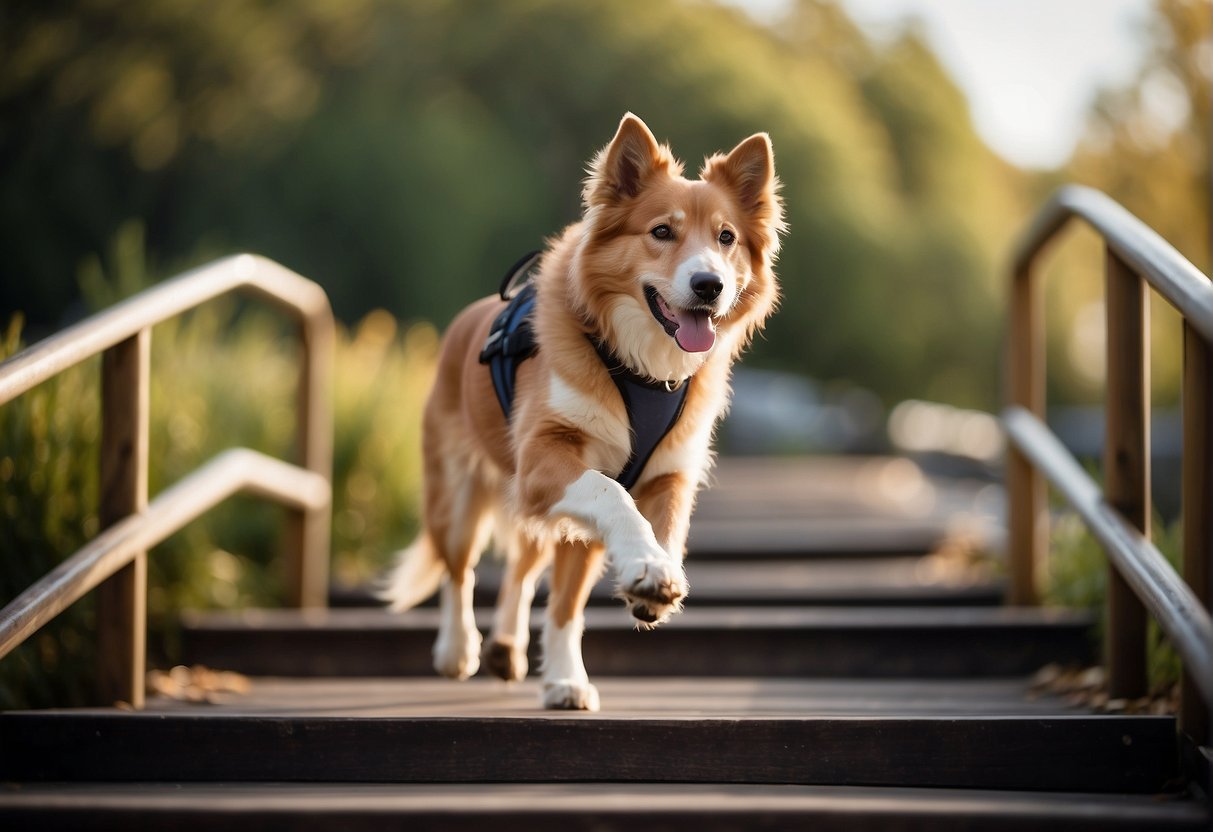
Types of Dog Ramps
Dog ramps come in a variety of designs to suit different needs and spaces. Whether you’re looking for something portable or a more permanent solution, there’s a ramp that can help your canine companion navigate heights safely.
Adjustable and Folding Designs
Adjustable ramps are versatile options, catering to varied heights and angles. These ramps typically feature a telescopic design, allowing you to extend or retract the length according to your needs.
They are ideal for use with multiple vehicles or furniture items. In the realm of portability and convenience, folding pet ramps stand out. Lightweight materials make these ramps easy to transport, and they fold down into a more compact size for storage.
Not all folding ramps are alike; some offer a tri-fold mechanism for an even smaller folded form. Many will support pets up to 200 lbs and provide an anti-slip surface for safe footing.
Permanent and Semi-Permanent Solutions
When you require a more stable setup, permanent ramps can be installed in your home or vehicle. These are often made of durable materials like wood or metal and are designed to stay in place for extended periods.
A wooden dog ramp, offers a sturdy and attractive addition to your home decor while ensuring your pet’s mobility is never compromised.
Semi-permanent solutions offer a balance between stability and flexibility. They can be securely fixed to one place, yet are also designed for easier removal when necessary.
These ramps may have features like rubber feet and high-traction surfaces to ensure safety and stability for your pet during use.
Use Cases for Dog Ramps

For Home Furniture
Beds and Couches: If your dog enjoys snuggling with you on the bed or relaxing on the couch, a dog ramp can make these areas easily accessible, especially for smaller breeds or senior pets with mobility issues.
- Safety: Using a ramp can prevent injuries caused by jumping off the bed or couch.
- Independence: A ramp empowers your pet to climb up and down without assistance.
- Promotes a sense of autonomy and confidence in your dog
- Allows your dog to maintain their routine and access their favorite spots
- Comfort: Allows your dog to snuggle with you or relax on the couch comfortably
For Vehicle Access
Cars and SUVs: Vehicles can pose a particularly challenging obstacle for dogs. A dog ramp provides a gentle and secure slope for your dog to enter and exit your car or SUV, ensuring a safe and easy process.
- Convenience: Portable ramps can be easily folded and stowed in your vehicle.
- Lightweight designs make them easy to handle and set up
- Some ramps come with carrying handles or storage bags for added convenience
- Support: Look for ramps that can support your dog’s weight—some can hold pets up to 200 lbs.
- Sturdy construction ensures stability and durability
- Wide walking surfaces provide ample space for your dog to navigate comfortably
Comparing Ramps, Stairs, and Steps
Dog ramps and dog stairs serve similar purposes but suit different needs.
- Dog Ramps: Ideal for dogs with joint issues, as they allow a gentle walk-up to furniture or vehicles.
- Dog Stairs: Better suited for dogs without mobility issues. They require a hopping action which can be strenuous.
- Dog Steps: Typically shorter, these work well for getting onto low furniture but, like stairs, they may put pressure on joints.
Consider the physical condition of your pet. If your dog has arthritis or other joint problems, a ramp is more appropriate than stairs or steps that cause additional strain.
Selection Criteria for Dog Ramps
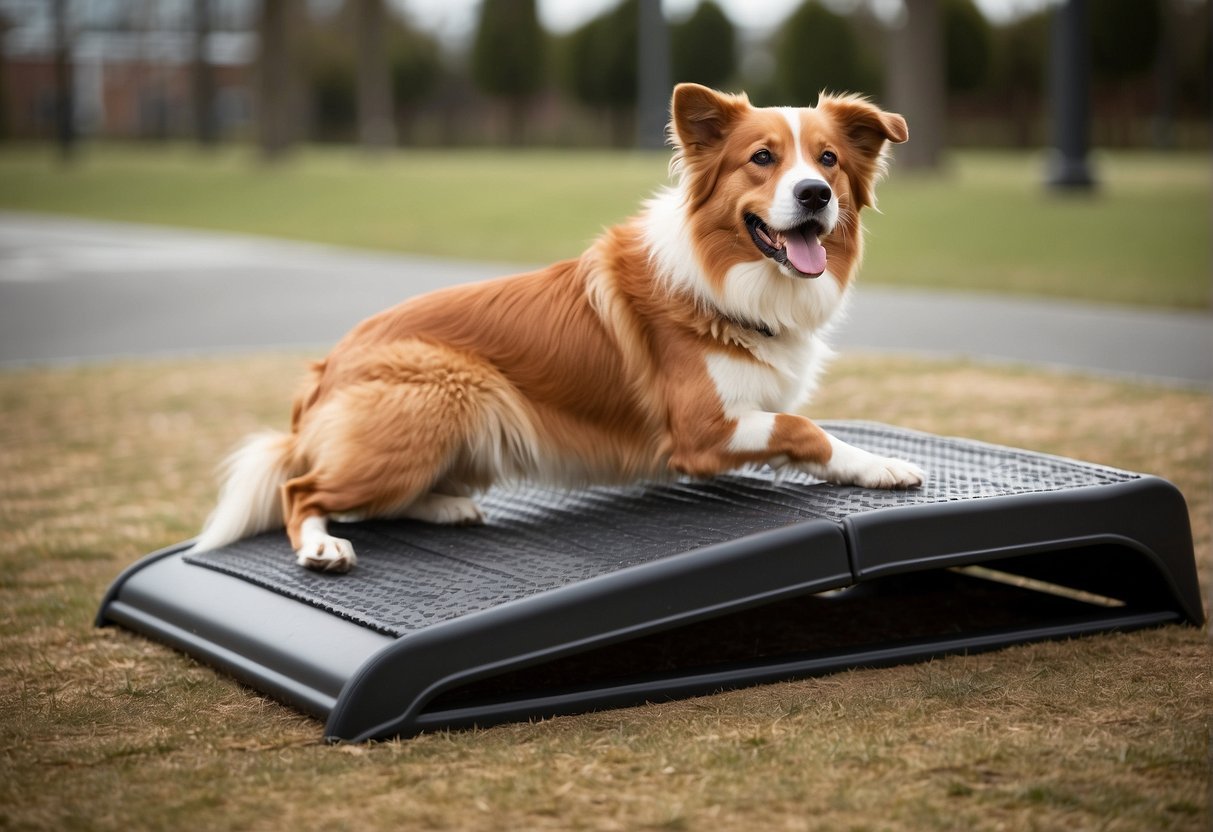
When selecting a dog ramp, your main focus should be on the size and weight capacity, the material and durability, and the safety features – ensuring a high traction, slip-resistant access point for your pet.
Size and Weight Capacity
For large dogs, it’s essential that the ramp can support their weight comfortably. The ramp should be long enough to provide a gentle slope for ease of use. This is crucial to prevent strain on their joints when climbing.
The safest dog ramp is one that has non-slip surfaces, side rails for greater security and stability, rubber feet to stay in place, and a latch to enhance portability.
Conversely, small dogs will benefit from a ramp with an incline angle between 18 to 20 degrees, allowing them for easier ascent and descent. A longer ramp provides a more gradual incline that’s easier on your dog’s joints.
Material and Durability
The material of the dog ramp influences both its durability and weight. Materials such as aluminum are lightweight yet sturdy for easier portability, while wooden ramps can be more durable but heavier.
For outdoor use, weather-resistant materials are vital. The construction should withstand the regular wear and tear of your dog’s activity to ensure longevity.

Traction and Safety Features
High traction non-slip surface is a safety imperative to prevent slipping, especially for older dogs or those with mobility issues. Many foldable dog ramps are odorless, non-toxic, and have a smooth surface.
Ramps with rubber feet offer additional stability and prevent the ramp from shifting during use. Adequate safety features give you peace of mind that your dog can use the ramp securely and with confidence.
Choosing the Right Ramp
When selecting a dog ramp, consider the length and incline. A longer ramp provides a more gradual incline that’s easier on your dog’s joints.
The ramp should also be sturdy and wide enough to support your dog’s weight and girth comfortably. Check for a ramp with a high-traction surface to prevent slipping.
- Length: Aim for a ramp length that provides a gentle slope.
- Strength: Ensure it supports your dog’s weight.
- Width: A wide ramp gives your dog confidence as they walk.
- Surface: Look for ramps with non-slip textures.
Specific Needs for Age and Health

When selecting a dog ramp, your pet’s age and health are important to keep in mind. Proper support for conditions such as arthritis and hip dysplasia can greatly enhance your dog’s mobility and quality of life.
- Here are a few reasons given by Doggo Ramps on why dog ramps are worth it:
- Using Ramps Can Prevent Dangerous And Expensive Injuries
- Less Stress On YOUR Back And Joints Over Time
- Dog Ramps Are Versatile
Senior Dogs and Arthritis
If your senior dog suffers from arthritis or seems hesitant to hop or jump, you’ll need to look for a dog ramp with features that minimize joint strain.
These ramps should have a gentler slope, providing easy ascent and descent, and include a non-slip surface to prevent falls that could further damage sensitive joints. Many senior dogs benefit from ramps with extra cushioning, which can be easier on their arthritic limbs.
Benefits for Joint Health
A well-designed dog ramp not only assists dogs with existing joint problems, but it can also serve as a preventative measure.
For breeds known to develop conditions like hip dysplasia, using a ramp early on can reduce the impact on their hips and joints during activities like climbing into a car or onto furniture.
Features such as adjustable height and supportive railings can provide tailored support to protect your dog’s joint health.
Mobility Issues and Recovery
For dogs with mobility issues or those recovering from surgery, a dog ramp is a safe and comfortable way to navigate your home and obstacles like stairs.
Look for ramps designed with gradual inclines and ample walking space to allow your dog to move without strain or discomfort. Adequate traction is essential to ensure stability, especially for dogs who may have weak limbs or balance issues.
Installation and Maintenance
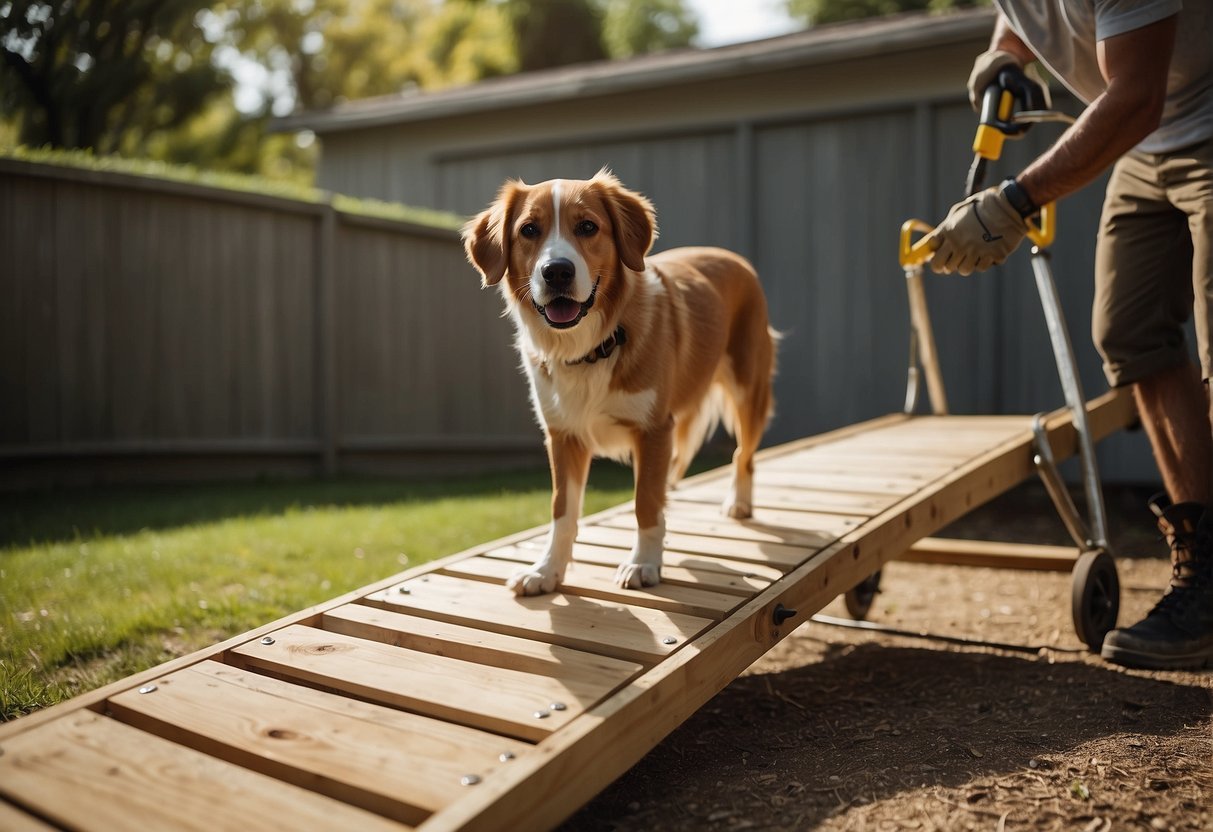
Setting Up Your Dog Ramp
Start by identifying the right location for your dog ramp. Make sure it is a stable surface that supports the weight of your dog without shifting.
If your ramp has adjustability features, set it to the height that best matches the entry point. This could be for your car, bed, or couch.
For storage convenience, opt for a ramp that is easy to store. If it comes with a built-in handle, transporting it will be hassle-free.
Ensure that the ramp is extended fully and locked into place, if applicable, to avoid collapsing.
- Positioning: Place on even ground, align with the entry point.
- Height Adjustment: Modify as needed for a gentle incline.
- Locking Mechanism: Secure locks to prevent movement.
- Storage: Fold or collapse the ramp if it’s designed to do so.
Cleaning and Upkeep
Keeping your dog ramp clean is essential for both hygiene and traction. If your ramp has a carpet surface, vacuum it regularly to remove dirt and pet hair.
Periodically check for any signs of wear or damage, particularly if the ramp is used outdoors. Look for loose screws or bolts, and tighten them as necessary.
If any part is damaged, replace it promptly to maintain the structural integrity of the ramp. Additionally, wiping down the surface with a damp cloth can help maintain the grip and prevent slippage.
- Vacuuming: Remove debris from the carpet surface.
- Inspection: Regularly check for any structural damage.
- Tightening: Secure all loose components.
- Wiping Down: Keep the ramp’s surface clean for optimal grip.
Accessories and Enhancements

When customizing your dog’s ramp, selecting the right accessories and enhancements can significantly boost safety and harmonize with your home decor.
These add-ons not only provide additional safety measures but also ensure that your pet’s access solutions fit seamlessly within your living space.
Additional Safety Measures
To prevent accidents, you might want to consider a raised rail that attaches to the side of the ramp, providing a barrier that helps keep your dog on track.
For traction control, especially for senior pets or those with mobility issues, a non-slip carpet surface is essential.
It gives your dog a reliable grip while ascending or descending, reducing the risk of slips and falls.
- Raised Rail: An essential add-on for keeping your pet on track.
- Non-Slip Carpet: Offers crucial traction for your dog’s paws.
Comfort and Decor Integration
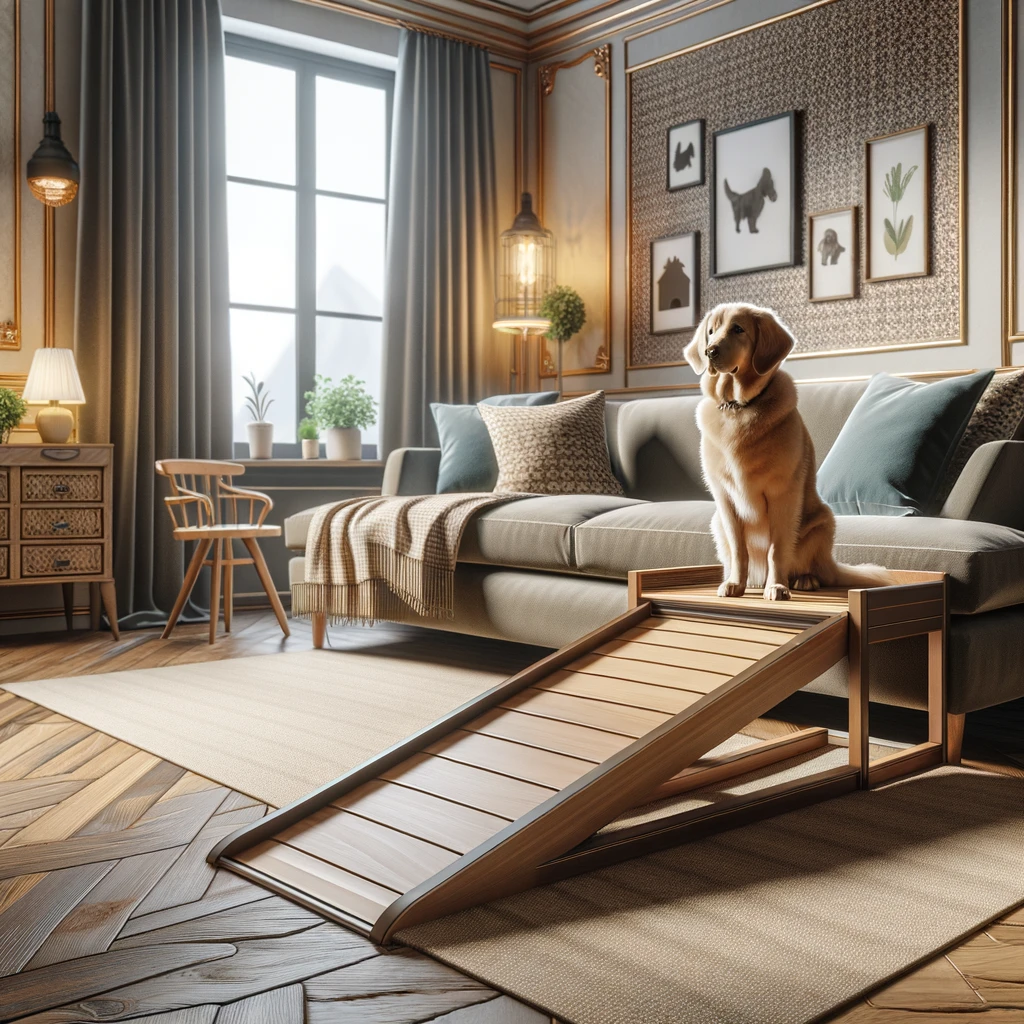
Similarly to a furniture style dog crate, a ramp that perfectly blends with your home’s aesthetic can be achieved with accessories like a carrying case that matches your decor. This makes storage easy and stylish.
Opt for an extra-wide ramp design if your dog enjoys more room, or if you have a larger breed. Wider ramps can be more comforting for dogs nervous about narrow pathways.
Keeping a stash of treats nearby can provide both a functional and decorative element. They can be used to train your dog to use the ramp and come in various containers that can add a decorative touch.
- Carrying Case: Ensures easy transport and stylish storage.
- Extra-Wide Design: Accommodates your dog’s need for extra space and comfort.
- Treats: Useful for training and as decorative elements with the right container.



